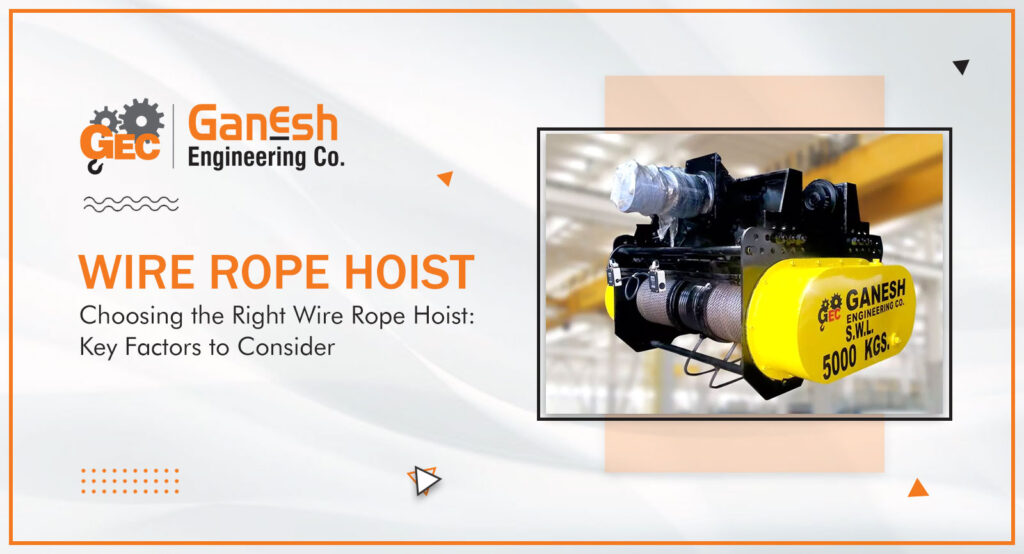
Selecting the right wire rope hoist is a critical decision for any business that relies on lifting and moving heavy loads. Whether you’re in construction, manufacturing, or logistics, a hoist wire rope is a key piece of equipment that can enhance operational efficiency, safety, and productivity. However, with various types, specifications, and features available, choosing the right hoist can be challenging. This blog will guide you through the key factors to consider when selecting the perfect rope hoist for your needs.
What is a Wire Rope Hoist?
Hoist wire ropes are lifting devices that utilize wire ropes to lift and lower loads. They are known for their strength, durability, and ability to handle heavy loads with precision. Among the various types of hoists, the electric wire rope hoist stands out due to its efficiency and ease of use. This type of hoist is powered by an electric motor, making it suitable for demanding industrial applications where lifting heavy loads frequently is required.
Key Factors to Consider When Buying Wire Rope Hoists
1. Load Capacity
The load capacity of a hoist is the maximum weight it can lift safely. It’s essential to choose a hoist with a load capacity that matches or exceeds your heaviest load. Overloading a hoist can lead to equipment failure and pose serious safety risks. When assessing load capacity, consider the heaviest item you need to lift, including any attachments or accessories.
2. Lifting Height and Speed
Lifting height refers to the maximum vertical distance the hoist can lift a load. Ensure that the hoist you choose has an adequate lifting height for your operations. Lifting speed is another crucial factor, as it affects the efficiency of your workflow. Some applications may require faster lifting speeds, while others might prioritize precision over speed.
3. Power Source and Duty Cycle
The power source of the hoist is a critical consideration. Electric wire rope hoists are popular due to their reliability and minimal maintenance requirements compared to manual or pneumatic hoists. Additionally, consider the duty cycle, which indicates how long the hoist can operate within a specific period without overheating. A higher duty cycle is ideal for applications requiring frequent or continuous lifting operations.
4. Safety Features
Safety is paramount when working with lifting equipment. Look for rope hoists equipped with essential safety features such as overload protection, emergency stop buttons, and limit switches that prevent the hoist from lifting beyond its maximum height. Anti-drop and anti-slip mechanisms are also beneficial in ensuring the load remains secure during operation.
5. Durability and Maintenance
The durability of the hoist determines its lifespan and reliability. Opt for hoists made from high-quality materials that can withstand harsh working environments. Regular maintenance is necessary to keep the hoist in optimal condition, so consider the ease of access to parts and the availability of service support when choosing a model.
6. Operational Environment
The environment in which the hoist will operate significantly impacts your choice. For example, hoists used in outdoor or hazardous environments should be designed to withstand extreme temperatures, moisture, dust, and other adverse conditions. Ensure the hoist you choose is suitable for your specific operational environment to prevent premature wear and tear.
7. Cost and Budget
While it’s important to stay within budget, the cheapest option isn’t always the best. Consider the total cost of ownership, including initial purchase price, installation, maintenance, and potential downtime costs. Investing in a high-quality electric wire rope hoist may have a higher upfront cost but can save money in the long run through improved efficiency and reduced maintenance expenses.
Conclusion
Selecting the right wire rope hoist requires careful consideration of several factors, from load capacity and lifting height to safety features and operational environment. By taking the time to evaluate your specific needs and options, you can select a hoist that enhances your operations’ efficiency and safety.

